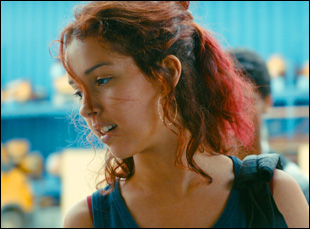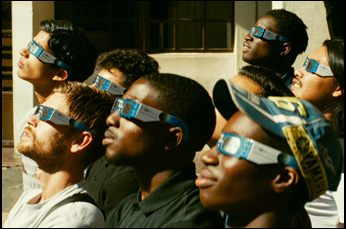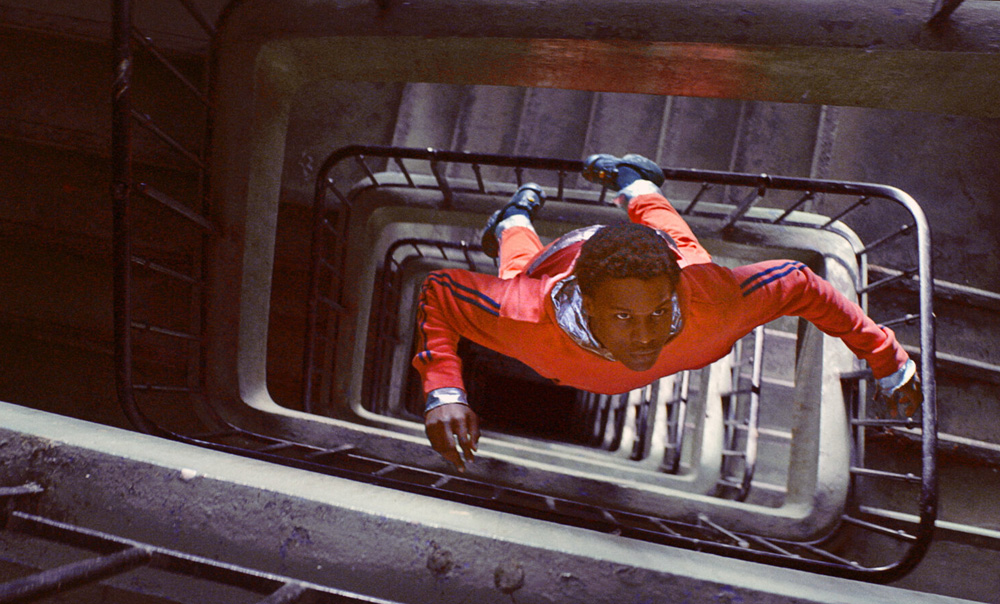Fanny Liatard and Jérémy Trouilh were always interested in building something, though it always wasn’t necessarily in film. The two met at college in Bordeaux where they were taking political science courses rather than anything related to production and shared an interest in urban renewal and rethinking public housing, ultimately going their separate ways to such countries as South America in Trouilh’s case and Lebanon in Liatard’s to look at the connections between communities and their places of residence. Trouilh had picked up a camera to make documentaries of his experiences at that time and upon his reunion with Liatard in their native France, she got the filmmaking bug too and what was once research became their raison d’être as they visited working class neighborhoods to see what their needs were.
That foundation became a launchpad in a number of ways for their enthralling feature debut “Gagarine,” set in the Parisian suburban projects named after the Russian astronaut Yuri Gagarin who first came to christen them in 1963. The basic necessities of everyday life may feel every bit as far away as the moon in the underserved community, but there are still those setting their sights on the stars such as Youri (Alseni Bathily), who takes inspiration from the wires that hang from the ceiling of his family’s flat to reimagine his surroundings as a spaceship. Like many living in the low-income housing, he already feels as if he’s got no firm ground beneath his feet, particularly with refugee roots, and Liatard and Trouilh brilliantly consider the gravity of the situation when his dreams of space travel become an escape from the fact that Gagarine has been marked for demolition, displacing all of its residents once more.
Although “Gagarine” is Liatard and Trouilh first foray outside of nonfiction, the two don’t stray far from reality, developing the sci-fi tinged drama alongside the real demolition of Gagarine and keeping in close contact with the community to bring their story to the screen in vivid detail, a process that involved recording oral histories of residents over generations to collect their own aspirations and disappointments over the years. While the film centers on Youri, it is enriched by continually peeking into the apartments of others, from Fari (Lyna Khoudri), a Romani activist trying to stave off the mass eviction, to the smoke-filled room of Dali (Finnegan Oldfield), who has different ideas about getting high than Youri does, and in presenting life in the building in such an ethereal and energetic way, the co-directors reveal there are likely as many wonders here on earth as there are elsewhere in the universe, if only one takes the time to look. Waiting out the pandemic to play in theaters after it was part of the Cannes selection of 2020 that never actually premiered on the Croisette, “Gagarine” is escapism at its finest and as it arrives on American shores, Liatard and Trouilh spoke about how they, as well as their cast and crew, could draw on experience in search of creating something new, finding a thematically appropriate and exciting visual language for the film and creating a community of their own with the production.

Jérémy Trouilh: Yeah, from the very beginning, we thought that a narrative story could happen here. We were invited by architect friends to make documentary portraits of the inhabitants of this building [that], at that time, was full of people, but the demolition had been decided. It just takes a lot of time to relocate everybody and when there is 400 apartments in the building, it’s even longer. [But] when we met this place, it looked like a spaceship from the very beginning and when we heard the stories there was an astronaut that had been there 60 years ago and all the utopias it represented at that time, and now this community had to be separated, we felt that a fiction could be perfect because both of us were willing to tell fictional stories. We remembered a script contest that was ending three days later, so we began with a short [script], we won this contest and it was six very intense months to do this first step as filmmakers [making a short]. Fifteen minutes wasn’t enough, so we kept on working with the inhabitants, with this place, with Youri for many more years to make this first feature film.
It sounds like you’re good with deadlines. Was there a ticking clock imposed on this production when the building was going to be demolished?
Fanny Liatard: Yeah, we were running out of time because the movie only made sense if we could shoot into the building, and writing the script took time. But we were so lucky to be able to enter the building and set it inside just before the demolition. The workers were entering the building on one side and we had this empty space in one part of the building to make all our spaceship, so it was interesting and also very emotional because all of the people who had left. Nobody was going to go [back] inside their apartments, so they left furniture and food sometimes on the table – objects, posters, postcards, so we used it in our sets to build Youri’s spaceship. Many of the people you see in the film are former inhabitants from the place, so they had the opportunity to come back and show us their apartments where they used to live and it gave a lot of energy on the set for the shooting.

Jérémy Trouilh: My mom is in this scene. [laughs] And many other moms from Gagarine. We really wanted to pay tribute to the women and the mothers in buildings such as Gagarine because many times in a project like that, they are the beating heart of the place and the ones who get the people together. We asked many of the women we met during the process of writing “Gagarine” to be part of the story, and actually, [that scene] was quite prepared. We worked with an amazing choreographer to invent a dance that would tell the strength of this group of women, kind of a Haka [war dance] that would include Yuri. We were lucky enough to shoot it on the rooftop of the real building, so of course all those elements make the moment, even though it was a fictional shooting, and sometimes we really felt the life was taking a step on fiction. In these kind of moments, we really felt we were living something real.
Fanny Liatard: And the cast was a mix between professional actors and beginners, as Alseni Bathily, the main actor had never [acted] before, so it was very interesting to get them to know each other. It took time for us to find the way to talk to [them] because it’s a different [approach] for each actor, but we were so lucky to work with Lyna Khoudri, Finnegan Oldfield and Farida Rahouadj, who had many experiences already, and at the same time, Alseni Bathily was so intense for a first-time [actor], he was incredible and I think for the other actors, it was also amazing to be with him. Alseni also had a coach who helped us for weeks to find strong feelings and because he was quite young — 17 years old — many things we were asking him maybe he had never felt before, so she was working with him to find this precise emotion and to be able to keep it and to make it go out again during the shooting. So it was a very interesting way to work and with the empty apartments and the presence of the former inhabitants, it gives a lot of energy to everybody because it’s a responsibility for Lyna Khoudri, for instance, to talk about this Roma community who was really for years very close to Gagarine, and [in general] it felt like a responsibility for all of the shooting team to make something beautiful.
I loved the shooting style of this, and this floating feeling that the cinematography had that could make it come across as zero gravity throughout. Was it difficult to get?
Jérémy Trouilh: Even though they go through a lot, we like to think of our characters [as] always looking up — they always have hope, so there was always this balance to find in the film between a world vanishing, but at the same time an elevation. So the zero gravity was a representation of the global metaphor, [where] at the beginning, it’s very [rooted] in his daily life and the film in its [visual] language is quite realistic, but little by little because he finds himself alone in this building and he needs to go deep into his emotions and his dreams to find resilience and we begin to have more complex camera movements and lighting and some stronger color palettes. [It’s] why it happens quite late in the movie when Yuri finally goes all the way into his dreams, it creates a duality of feeling when Yuri is alone in the space, floating with his building becoming an actual spaceship, and there is no more sound — on one hand, it’s quite exciting because he’s accomplishing his dream, but at the same time, you can feel that life [on earth] is going away, so he will need to go back and his community [still needs] to be saved, so the balance between magical realism, fantasy and the sci-fi inspirations and the importance of this real community was something we tried to find through Yuri’s point of view.

Fanny Liatard: In a way, we can’t believe it because it was not planned like that. It started with a short film eight years ago, so we made it little by little and meeting a lot of people that gave a lot of energy. Of course now we’re so proud that the film has been selected into Cannes, but we couldn’t because of the pandemic, but at the end, of course, when we were showing the movie for the first time to everybody there, very close to the building, there’s a cinema and it was amazing to realize we made it together, many different people, professional and nonprofessional. That was such a joy and we were proud to have made that together.
Also, it gave us a lot of energy to go on with other projects. We’re writing now other films and we hope it will be the same beautiful adventure it was with “Gagarine.” We feel lucky because some producers and financiers that trusted us and made it possible. It’s such a collective way of working and we love it. We have a beautiful family working with us now.
“Gagarine” will open on April 1st in select theaters including in New York at the Quad Cinema and Los Angeles at the NuArt, the Encino Town Center, the Pasadena Playhouse, the NoHo 7, and the Claremont 5.




